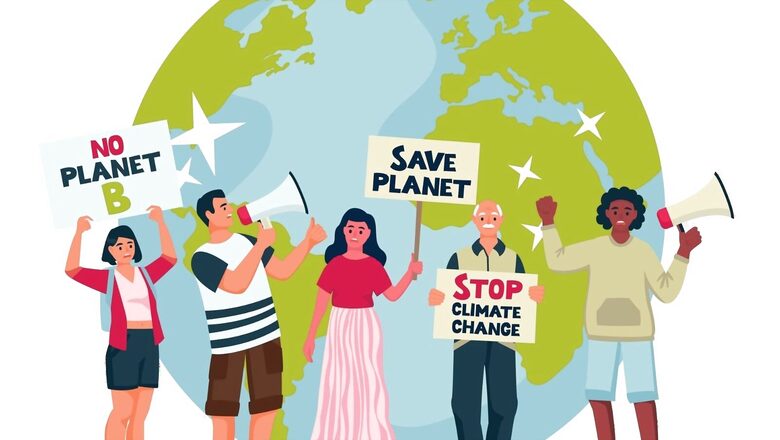
views
Homi Bhabha, India’s great nuclear visionary, envisioned India’s development of nuclear power in three stages.
Stage one would be using uranium for producing power which creates plutonium as a by-product. India is currently in this stage with 7 nuclear plants having 22 reactors with installed capacity of around 7 GW (1.7 percent of installed capacity) with more under development.
Stage two would be using the plutonium recovered from stage one along with uranium. The resulting nuclear reaction would create more plutonium than was used as fuel which can then be used for setting up more plutonium powered reactors. In addition, thorium is introduced into the fuel mix which gets converted to uranium which would be used for stage three. India is currently on the cusp of realising stage two with the BHAVINI Prototype Fast Breeder Reactor which is on the verge of being commissioned in Kalpakkam, Tamil Nadu.
In stage three, the uranium produced in stage two (using thorium) will be mixed with more thorium to fuel reactors. This will allow India to exploit its large thorium reserves (25 percent of global reserves) and hence achieve what Bhabha envisioned — reduce dependence on imported uranium and be aatmanibhar in nuclear fuel. Achieving stage three is expected to take a few more decades.
India has ambitious climate goals. In order to meet its commitments under the Paris Agreement, Prime Minister Narendra Modi has set a stiff target of 500 GW of electricity from renewable sources by 2030. India’s Ministry of New and Renewable Energy doesn’t classify nuclear power as renewable energy. But rather than looking at energy from a renewable lens, let’s look at it from a fossil fuel (non-green) and non-fossil fuel (green) perspective. Green power includes nuclear power as well.
The Russian invasion of Ukraine and the resultant knee-jerk sanctions by the West on Russia has affected critical gas supplies from Russia to the European Union (EU.) This has exposed the heavy dependence of the EU on Russia for their energy security. In order to improve their energy security, the European Parliament (the legislative arm of the EU) had recently voted to re-classify the taxonomy of nuclear power and gas as “green” energy. This is a tectonic shift for the EU driven by a shotgun wedding of the interests of the French (who favour nuclear — given 60%+ on average of their power generation in recent years has been via nuclear generation) and the Germans (who favour gas and have an instinctive distrust of nuclear power.)
This means that public and private financing in nuclear and gas now get the “green” tag. Hence, more money will flow into these projects given the large amount of money earmarked for green projects. For example, the EU has opened a spigot of EUR 1 trillion between 2021-27 to fund their Green Deal programme. With gas and nuclear power being classified as green, they now qualify for these funds. Private financing, which of late is scouting for more green financing opportunities, would be encouraged by the change in taxonomy to provide more financing for nuclear power. Not every entity within the European Union is happy with this development though. The European Investment Bank — EU’s development finance bank and one of the largest climate investors in the world — has refused to accept this change in taxonomy for nuclear and gas.
The politics of nuclear power within the EU notwithstanding, the pragmatism in recognising nuclear and gas as “green” investments may help improve public and private investments in these sectors across the globe, especially in India. This is important for India because nuclear power is critical for the energy transition.
India’s peak power demand hit 215 GW in May 2022 with tremendous growth expected going forward. Increasing nuclear power in our energy mix makes climate sense as nuclear power has a small carbon footprint (50 gCO2/kWh) compared to gas generated power (450 gCO2/kWh) or coal generated power (1,050 gCO2/kWh). In other words, nuclear power generates 5 percent of the CO2 compared to coal-fired thermal power. This makes it an obvious contender for the energy transition.
Nuclear power produces a low volume of waste which can be safely stored away. More technologies are evolving that aim to make it safer to store nuclear waste. In addition, India’s three-stage nuclear power programme means that spent fuel from one stage is enriched and reused in subsequent stages before disposal, hence reducing use of nuclear fuel.
It is easy to dismiss nuclear power given the accidents which have occurred. But one needs to think beyond the sensationalist headlines and the shrill foreign-funded environmental campaign against it because of the several advantages it offers. Unlike coal and gas, it is a low carbon energy source. Unlike wind and solar, it is reliable and available 24x7x 365. India has a long, consistent safety record in nuclear power. Nuclear power plant design and waste disposal mechanisms have become safer over time. While India doesn’t have much uranium, it holds the third largest reserves of thorium which would help achieve Bhabha’s dream of being wholly self-sufficient in nuclear power.
India need not mimic France which recently achieved 60 percent of its electricity generation from nuclear power. But a target of, say, 25 percent of electricity generation from nuclear power is doable and necessary for India to meet its burgeoning energy needs while managing climate change. Nuclear power can be a powerful arrow in India’s fight against climate change.
Arun Krishnan is an independent consultant working in climate change and infrastructure. Views expressed are personal.
Read all the Latest News, Breaking News, watch Top Videos and Live TV here.


















Comments
0 comment